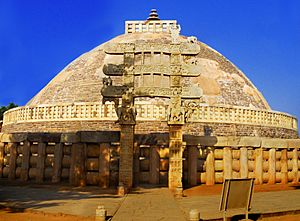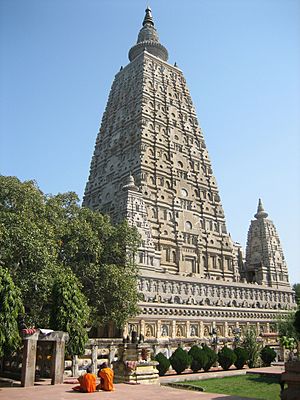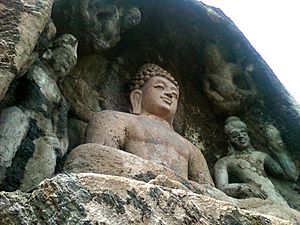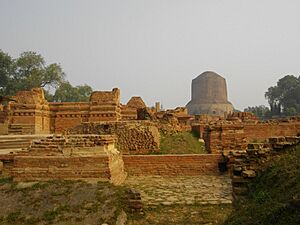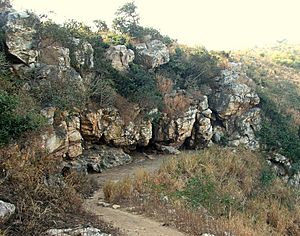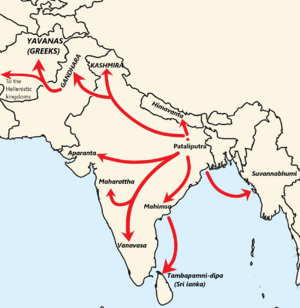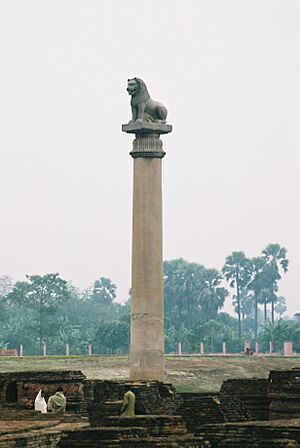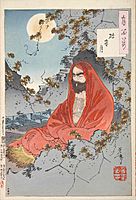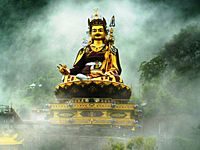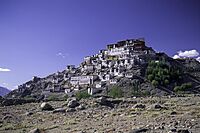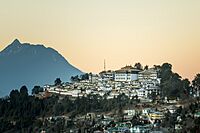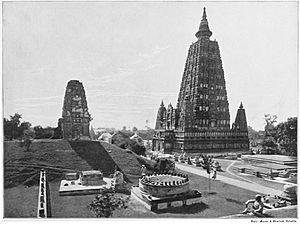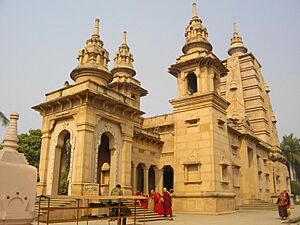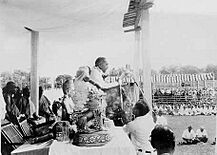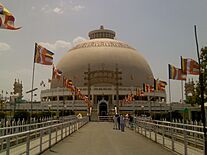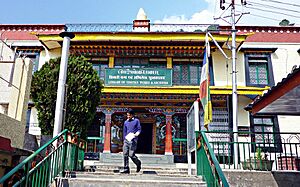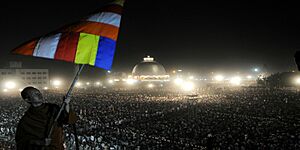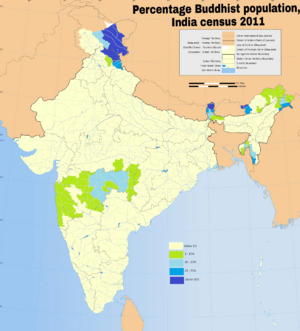History of Buddhism in India facts for kids
|
Basic terms |
|
|
People |
|
|
Schools |
|
|
Practices |
|
|
study Dharma |
|

Buddhism is an ancient Indian religion that started in the area of Magadha (now Bihar, India). It is based on the teachings of Gautama Buddha, who was called an "Awakened One." Buddhists believe there were other Buddhas before him. Buddhism began to spread outside Magadha even during Buddha's lifetime.
Later, during the time of Emperor Ashoka of the Maurya Empire, the Buddhist community split into two main groups: the Mahāsāṃghika and the Sthaviravāda. These groups then spread across India and divided into many smaller branches. Today, there are two major types of Buddhism: Theravada in Sri Lanka and Southeast Asia, and Mahayana in the Himalayas and East Asia. Vajrayana Buddhism is sometimes seen as part of Mahayana, but some experts think it's a separate branch.
Buddhism became less popular in India around the 7th century CE, after the Gupta Empire fell. The last big kingdom to support Buddhism, the Pala Empire, ended in the 12th century. By the late 1100s, Buddhism had mostly disappeared from India, except for the Himalayan areas and a few places in South India. However, since the 1800s, Buddhism has seen a comeback with groups like the Maha Bodhi Society and the Vipassana movement. The Dalit Buddhist movement, led by B. R. Ambedkar, also helped. Tibetan Buddhism has also grown in India since Tibetan refugees and their government came to India after the Chinese occupation of Tibet in 1950. In 2011, about 8.4 million Buddhists lived in India, which was 0.70% of the total population.
Contents
- Understanding Early Buddhism in India
- How Buddhism Grew and Changed
- Buddhism Spreads and Grows Stronger
- Important Buddhist Teachers
- Why Buddhism Declined in India
- Buddhism's Comeback in India
- Buddhist Culture and Communities
- Types of Buddhism in India
- Buddhist Population in India
- More About Buddhism in India
Understanding Early Buddhism in India
Who Was Gautama Buddha?
Gautama Buddha was born as Siddhārtha Gautama. His father, Suddhodana, was a leader of the Shakya republic in Kapilvastu. He practiced spiritual methods but avoided extreme ways of living, like being too strict with himself or only focusing on meditation. Instead, he taught a "Middle Way." This path avoids being too self-indulgent or too harsh on oneself. It focuses on self-control and kindness.
According to old stories, Siddhārtha Gautama became "awakened" while sitting under a pipal tree. This tree is now known as the Bodhi tree in Bodh Gaya, India. Gautama called himself the tathagata, meaning "thus-gone." Later, people saw him as a Samyaksambuddha, a "Perfectly Self-Awakened One." The ruler of Magadha, Emperor Bimbisāra, supported him. The emperor became a Buddhist and allowed many Buddhist temples, called "Vihāras," to be built. This is why the whole region was later named Bihar.
Stories say that in the Deer Park in Sarnath, near Vārāṇasī in northern India, Buddha gave his first sermon. This event is called "setting the Wheel of Dharma in motion." He spoke to five friends who had been seeking freedom with him. They, along with Buddha, formed the first Saṅgha, which is the community of Buddhist monks. This completed the first "Triple Gem": Buddha, his teachings (Dharma), and the community (Sangha).
For the rest of his life, Buddha is said to have traveled across the Gangetic Plain in Northern India and other areas. He passed away in Kushinagar, Uttar Pradesh, India. Historians believe he died around 400 BC, at the age of 80.
Followers of Buddha
People who follow Buddhism are called Buddhists. In ancient India, they also called themselves Saugata, Sakyans, Sakyabhiksu, Sakyaputto, Ariyasavako, or Jinaputto. The scholar Donald S. Lopez says they also used the term Bauddha. However, another scholar, Richard Cohen, notes that Bauddha was mostly used by outsiders to describe Buddhists.
How Buddhism Grew and Changed
Early Buddhist Meetings
Buddha did not choose a leader after him. He told his followers to work towards freedom by following his teachings. At first, Buddha's teachings were only passed down by word of mouth. So, the Sangha (the community of monks) held several Buddhist councils to agree on Buddhist teachings and rules for monks.
- The first Buddhist council was led by Mahākāśyapa, a student of Buddha, in Rājagṛha. Its goal was to remember and agree on Buddha's teachings and monastic rules. Some scholars think this council might not have happened.
- The Second Buddhist Council is said to have happened in Vaiśālī. It dealt with questions about monks using money or drinking palm wine. The council decided these practices were not allowed.
- The Third Buddhist Council was held in Pāṭaliputra. Emperor Aśoka supposedly called it in the 3rd century BC. It was organized by the monk Moggaliputta Tissa to remove monks who had joined just for royal support. Most scholars now believe this council was only for the Theravada group.
- The Fourth Buddhist council is thought to have been held in Kashmir under Emperor Kanishka. Some scholars doubt if it truly happened. It is believed to have been a council for the Sarvastivāda school.
Early Buddhist Groups
The first Buddhist groups formed in the centuries after Buddha passed away. The earliest split was between the Mahāsāṃghika (the larger group) and the Sthaviravāda (the smaller group). Some Buddhist traditions today still follow the rules (vinayas) of these early schools.
- Theravāda: Practiced mainly in Sri Lanka, Myanmar, Thailand, Cambodia, Laos, and Bangladesh.
- Dharmaguptaka: Followed in China, Korea, Vietnam, and Taiwan.
- Mūlasarvāstivāda: Followed in Tibetan Buddhism.
The Dharmaguptakas worked hard to spread Buddhism outside India, to places like Afghanistan, Central Asia, and China. They were very successful. Because of this, most countries that adopted Buddhism from China also adopted the Dharmaguptaka rules for monks (bhikṣus) and nuns (bhikṣuṇīs).
Early Buddhist groups in India often described different ways of practicing Buddhism as "vehicles" (yāna). For example, the Vaibhāṣika Sarvāstivādins believed in three vehicles:
- Śrāvakayāna
- Pratyekabuddhayāna
- Bodhisattvayāna
Mahayana Buddhism

Many experts think that the Prajnaparamita sutras, which are some of the oldest Mahayana texts, developed among the Mahasamghika group. This happened along the Krishna River in the Andhra region of South India.
The first Mahayana texts, including early versions of the Prajnaparamita and writings about Akṣobhya Buddha, were likely written in South India in the 1st century BC. Scholars like Guang Xing and A.K. Warder suggest that Mahayana Buddhism started in South India, especially in the Andhra region.
Historians also point out that important Mahayana thinkers like Nāgārjuna and Dignaga developed their ideas while living in Buddhist communities in Andhra. Ancient Buddhist sites in the lower Krishna Valley, such as Amaravati Stupa and Nāgārjunakoṇḍā, date back to at least the 3rd century BCE. This suggests that many early Mahayana scriptures came from South India.
Vajrayana Buddhism
Different types of Vajrayana writings appeared because royal families supported both Buddhism and Shaivism (a Hindu tradition). Some texts, like the Mañjusrimulakalpa, say that mantras from Shaiva, Garuda, and Vaishnava traditions would work for Buddhists. This is because they were all originally taught by Manjushri. Some Vajrayana texts even suggested acting as a Shaiva teacher.
Buddhism Spreads and Grows Stronger
How Buddhism First Spread
In the 6th and 5th centuries BC, trade and business grew, making merchants more important. Merchants liked Buddhist teachings because they were different from the Brahmin religious practices of the time. Brahmin practices focused on the high social position of the Brahmin caste, which didn't always include other classes. Buddhism became popular among merchants. It then spread throughout the Mauryan empire through trade routes and business connections. This is how Buddhism also traveled along the silk route into Central Asia.
Ashoka and the Mauryan Empire
The Mauryan Empire was strongest under Emperor Ashoka. He became a Buddhist after the Battle of Kalinga. This led to a long time of peace under his Buddhist rule. The empire was very powerful, and ambassadors were sent to other countries to share Buddhism. Greek visitors like Megasthenes wrote about the rich capital city of the Mauryan Empire. Stupas, pillars, and stone messages (called edicts) can still be seen at Sanchi, Sarnath, and Mathura. These show how large the empire was.
Emperor Ashoka the Great (304 BC–232 BC) ruled most of India from 273 BC to 232 BC. His kingdom stretched from parts of Afghanistan in the north to Bengal and Assam in the east, and as far south as Mysore.
Stories say that Emperor Ashoka felt very bad after conquering Kalinga. After this, he accepted Buddhism as his personal faith. He built monuments at important places in the life of Śakyamuni Buddha. Buddhist traditions say he was very involved in keeping Buddhism alive and spreading it.
Recent digs in Lalitgiri in Odisha found four monasteries and old seals. These show that Buddhist culture continued from the Mauryan period until the 13th century AD. Similar history has been found in Ratnagiri and Konark in Odisha. A museum has been built to protect this ancient history.
Later Empires and Buddhism
Menander was a famous king from Bactria. He ruled from Taxila and later from Sagala. He rebuilt cities and became a Buddhist. He is remembered in Buddhist writings for his talks with a great Buddhist philosopher in the book Milinda Pañha.
By 90 BC, Parthians took over eastern Iran. Around 50 BC, they ended Greek rule in Afghanistan. By 7 AD, an Indo-Parthian family took control of Gandhāra. Parthians continued to support Greek art in Gandhara. The unique Greco-Buddhist art of Gandhara started between 50 BC and 75 AD.
Kushan Empire and Buddhist Art
The Kushan Empire ruled large parts of northern India from about 60 to 270 AD. This included the Buddhist region of Gandhara, which is now parts of Afghanistan and Pakistan. Kushan rulers supported Buddhist places and built many stupas and monasteries. Some of their coins even showed an image of Buddha. During this time, Gandharan Buddhism spread through trade routes protected by the Kushans. It went through the Khyber Pass into Central Asia. Gandharan Buddhist art also spread to other parts of Asia.
The next major rulers, the Gupta Empire (around 319 to 467 AD), were Hindus. Buddhism began to decline, especially in western North India, during this period.
The Pala and Sena Dynasties
Under the kings of the Pāla (around 730-1130) and Sena (around 1070-1230) families, large Buddhist universities (mahavihars) thrived in what is now Bihar and Bengal. They received much support from the kings. Tantric Buddhism was very strong here and spread to Tibet. Tibetan sources mention five great mahavihars: Vikramashila, Nalanda, Somapura, Odantapurā, and Jaggadala. These five monasteries worked together like a network. Scholars often moved between them.
During this time [Pala dynasty], Mahayana Buddhism became very advanced. Tantric Buddhism also grew across India and nearby lands. This was also an important time for Buddhist philosophy. Many foreign visitors came to India, especially from China and Tibet. Also, many Indian scholars traveled to Tibet.
Important Buddhist Teachers
-
Atiśa (11th century) helped spread Mahayana and Vajrayana Buddhism in Asia.
Indian spiritual teachers (called śramaṇa) spread Buddhism to many places, including East Asia and Central Asia.
In his stone messages, Emperor Ashoka mentions sending Buddhist teachings to Greek kings. The Mahavamsa says that Ashoka sent people like Dharmaraksita, who led Greek Buddhist monks to spread Buddhism.
Roman historical writings describe an embassy sent by an "Indian king Pandion" to Caesar Augustus around the 1st century. One member of this group was a sramana who burned himself alive in Athens to show his faith. This event caused a stir and was written about by Nicolaus of Damascus and Strabo. A tomb was made for the sramana, which said: "The sramana master from Barygaza in India."
Lokaksema was the first known Buddhist monk to translate Mahayana Buddhist scriptures into Chinese. Gandharan monks Jnanagupta and Prajna also translated many important Sanskrit texts into Chinese.
The Indian meditation master Buddhabhadra was the first head of the Shaolin Temple. Bodhidharma (around 6th century) is traditionally seen as the founder of Zen Buddhism in China.
In 580, the Indian monk Vinitaruci traveled to Vietnam. This was the start of Vietnamese Zen, or Thien Buddhism.
Padmasambhava, meaning "lotus-born," is said to have brought Tantric Buddhism to Tibet in the 8th century. In Bhutan and Tibet, he is known as "Guru Rinpoche" ("Precious Master"). Followers of the Nyingma school see him as the second Buddha.
Shantaraksita, a leader of Nalanda and founder of a Buddhist philosophy, is said to have helped Padmasambhava establish Buddhism in Tibet.
The Indian monk Atisha helped start the Geluk school of Tibetan Buddhism. Indian monks like Vajrabodhi also traveled to Indonesia to spread Buddhism.
Why Buddhism Declined in India
Many reasons are given for the decline of Buddhism. Usually, kingdoms treated all major religions fairly, building monasteries and giving land to support monks. This support was very important for Buddhism because its monks relied on donations.
Old writings from India, Tibet, and China show that support for Buddhist monasteries was sometimes stopped during wars. But it generally continued in Hindu kingdoms from the start of the common era until the early 12th century. Modern studies suggest that Buddhist monks owned property and were involved in trade.
With the Gupta dynasty (around 4th to 6th century), Mahayana Buddhism became more focused on rituals. Hinduism and Buddhism also influenced each other. The differences between them became less clear. Hindu traditions like Vaishnavism and Shaivism grew more popular. Buddhist monasteries slowly lost control of their land. At the same time, Gupta kings built Buddhist temples and universities like Nalanda.
Some scholars say Buddhism declined partly because Brahmins gained more power. Others argue that Buddhism's rise or fall was not linked to Brahmins or the caste system. They say Buddhism was not a protest against the caste system, but aimed to help those who joined its monastic order find salvation.
The traveler Al-Biruni wrote in the 11th century that there was "cordial hatred" between Brahmins and Buddhist monks. Buddhism was also weakened by rival Hindu philosophies and the growth of the bhakti movement. This competition reduced support for Buddhism. By the early 11th century, Buddhism had disappeared from Afghanistan and North India due to Muslim conquests of Afghanistan and attacks on India.
Some scholars, like Lars Fogelin, suggest that economic reasons played a role. Buddhist monasteries with large land grants might have focused too much on spiritual things and become isolated. They might also have lost discipline or failed to manage their land well.
Hun Invasions
Chinese scholars who traveled through India between the 5th and 8th centuries, like Faxian and Xuanzang, wrote about the decline of the Buddhist Sangha. This was especially after the Hun invasions from Central Asia. Xuanzang found that "millions of monasteries" in northwest India were destroyed by the Huns.
Muslim Conquerors
The Muslim conquest of the Indian subcontinent was the first major destruction of religious images in South Asia. By the end of the 12th century, Buddhism had mostly disappeared. Monasteries and stupas were destroyed in medieval northwest and western India.
In northwest India, Buddhism had helped trade. With the Islamic invasions and Central Asians becoming Muslim, the financial support from trade routes for Buddhist monasteries decreased. This hurt the economic base of Buddhism. The arrival of Islam also ended royal support for Buddhist monks. Muslims replaced Buddhists in long-distance trade, cutting off another source of support.
In the Gangetic plains, Odisha, northeast, and southern India, Buddhism survived into the early 12th century. The Islamic invasions took wealth and destroyed Buddhist images. They also took over land owned by Buddhist monasteries, which was a key source of support. Economic problems and new taxes on ordinary people also reduced their ability to support Buddhist monks.
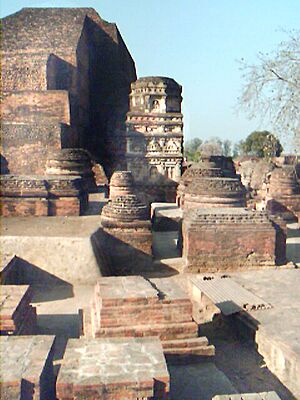
Monasteries like Nalanda were left empty or destroyed from the 8th to 15th centuries. Monks had to flee to escape the invading Muslim army. After this, the sites fell into ruin during the Islamic rule in India.
The last empire to support Buddhism, the Pala dynasty, fell in the 12th century. Muhammad bin Bakhtiyar Khalji, a general, destroyed monasteries and monuments and spread Islam in Bengal. Some scholars say Buddhism was already declining before the 12th century. But the attacks by Muslim invaders almost made it disappear in India in the 1200s. In the 13th century, Buddhist monks in India fled to Tibet to escape. Monks in western India moved to Hindu kingdoms in South India that could resist Muslim power.
Buddhists Who Survived
Many Indian Buddhists went south. We know Buddhists still existed in India after the 14th century from texts like the Chaitanya Charitamrita. This text tells a story about Chaitanya Mahaprabhu (1486–1533), a Hindu saint, who debated with Buddhists in Tamil Nadu.
The Tibetan writer Taranatha (1575–1634) wrote a history of Indian Buddhism. He said Buddhism survived in some parts of India during his time. He mentioned Buddhist communities in Konkana, Kalinga, Mewad, Chittor, Abu, Saurastra, Vindhya mountains, Ratnagiri, and Karnataka. A Jain writer, Gunakirti (1450-1470), listed 16 Buddhist groups. Some of their names, like Sataghare and Dongare, are still family names in Maharashtra today. The great monastery at Ratnagiri, Odisha, seems to have continued with fewer monks until the 16th century. It might have been funded by foreign visitors because it was near the coast.
Buddhism also survived in Himalayan regions like Ladakh until modern times, with strong ties to Tibet. A unique tradition still exists in Nepal's Newar Buddhism. The most important Buddhist pilgrimage sites in India, like Bodh Gaya, continued to receive visitors from outside India. Now, with easier air travel, many more pilgrims visit.
In Bihar and Bengal, many Buddhist shrines and temples remained. The Buddha or Bodhisattva statues inside were sometimes taken over and worshipped as Hindu gods. Near Nalanda, the remains of small stupas are worshipped as Shiva lingas. A Buddha statue in Telhara is worshipped as Hanuman during Rama Navami. A Buddha sculpture in Comilla became a statue of Vāsudeva.
Abul Fazl, a courtier of Mughal emperor Akbar, wrote that "scarce any trace of them (the Buddhists) has existed in Hindustan" for a long time. When he visited Kashmir in 1597, he met a few old men who said they were Buddhist, but he saw no learned Buddhists. This also shows that Buddhist priests were not present among the learned religious leaders who came to Akbar's meeting place.
-
Tawang Monastery in Arunachal Pradesh, built in the 1600s, is India's largest monastery.
Reasons for Decline within Buddhism
Some scholars suggest that Buddhist monasteries declined partly because they became separate from daily life in India. They did not take part in common social rituals like weddings, funerals, or child births, unlike other religions.
Buddhism's Comeback in India
Maha Bodhi Society and Modern Revival
The modern return of Buddhism in India began in the late 1800s. It was led by groups like the Maha Bodhi Society (1891), the Bengal Buddhist Association (1892), and the Young Men's Buddhist Association (1898). These groups were influenced by modern Buddhist ideas from Sri Lanka and Western studies of Eastern cultures.
A key person in this movement was Anagarika Dharmapala, a Buddhist leader from Sri Lanka. He founded the Maha Bodhi Society in 1891. A main goal of the society was to find, protect, and restore important Buddhist sites in India, like Bodh Gaya and its Mahabodhi temple. Dharmapāla and the society also encouraged building Buddhist temples (vihāras) in India, including one at Sarnath, where Buddha gave his first sermon. Dharmapāla became a monk and passed away in 1933.
After India became independent, its ancient Buddhist history became important for building the new nation. Prime Minister Jawaharlal Nehru looked to the Mauryan empire for symbols that united all Indians, like the Dhammachakra. Indian Buddhist sites also received government support for the 2,500th Buddha Jayanti in 1956. The government also gave free land in pilgrimage centers for Asian Buddhist groups to build temples and guesthouses.
Important Indian Buddhist thinkers of modern times include Rahul Sankrityayan and Dharmanand Kosambi. The Bengali Buddhist Kripasaran Mahasthavir founded the Bengal Buddhist Association in 1892. In Tamil Nadu, Iyothee Thass was a key figure who promoted Buddhism and encouraged the Paraiyar people to convert.
The Indian government and states continue to promote Buddhist pilgrimage sites ("the Buddhist Circuit"). This helps tourism and highlights India's Buddhist heritage, which is important for India's relationships with other countries. In 2010, the Nalanda University was re-established in Bihar.
Dalit Buddhist Movement
In the 1950s, the Dalit political leader B. R. Ambedkar (1891-1956) started encouraging low-caste Dalits in India to convert to Buddhism. He was influenced by Buddhist texts and Indian Buddhists like Dharmanand Kosambi. His Dalit Buddhist Movement was most successful in Maharashtra, where many people converted. Ambedkar's "Neo Buddhism" strongly protested against Hinduism and the Indian caste system. His main work, The Buddha and His Dhamma, included ideas of social struggle. He argued that Buddhist morals could help "reconstruct society and build a modern, fair, equal, and free society."
This conversion movement has mostly been limited to certain social groups, like the Mahar caste of Maharashtra and the Jatavs. Even though they have left Hinduism, a survey showed they still follow many old practices, like marrying within their group and worshipping traditional family gods.
Major groups in this movement are the Buddhist Society of India and the Triratna Buddhist Community.
Tibetan Buddhism in India
Tibetan Buddhism has also grown in India in modern times, mainly because many Tibetans now live there. The arrival of the 14th Dalai Lama with over 85,000 Tibetan refugees in 1959 greatly helped Buddhism revive in India. Many Tibetans settled in Dharamsala, Himachal Pradesh, which became the main place for the Tibetan Government in Exile. Another large Tibetan refugee settlement is in Bylakuppe, Karnataka. Tibetan refugees also helped bring Buddhist traditions back to Himalayan regions like Lahaul and Spiti, Ladakh, Tawang, and Bomdila. Tibetan Buddhists have also helped build temples and centers at Buddhist sites in India.
The Dalai Lama's brother, Gyalo Thondup, lives in Kalimpong. His wife started the Tibetan Refugee Centre in Darjeeling. The 17th Karmapa also came to India in 2000. He continues his education and leads the Karma Kagyu sect of Tibetan Buddhism. Every year, he leads the Kagyu Monlam in Bodh Gaya, attended by thousands of monks and followers. Palpung Sherabling monastery, the seat of the 12th Tai Situpa in Kangra, Himachal Pradesh, is the largest Kagyu monastery in India. It has become an important center for Tibetan Buddhism. Penor Rinpoche, the head of Nyingma, the oldest school of Tibetan Buddhism, rebuilt a Nyingma monastery in Bylakuppe, Mysore. This is the largest Nyingma monastery today. Monks from Himalayan regions of India, Nepal, Bhutan, and Tibet come to this monastery for higher education. Penor Rinpoche also founded Thubten Lekshey Ling, a dharma center for regular people in Bangalore. After this, Vajrayana Buddhism and Dzogchen meditation became available again to people in India.
Vipassana Meditation Movement
The Vipassana movement is a modern way of practicing Buddhist meditation. In India, the most important Vipassana group is the Vipassana Research Institute. It was founded by S.N. Goenka (1924-2013). He promoted Buddhist Vipassana meditation in a modern way that was open to everyone. Goenka's network of meditation centers offered 10-day retreats. Many organizations, both government and private, now offer these courses to their employees. This type of meditation is mainly practiced by well-off and middle-class Indians. This movement has spread to many other countries in Europe, America, and Asia. In November 2008, the Global Vipassana Pagoda was finished building near Mumbai.
Buddhist Culture and Communities

Buddhist Communities in India
Marathi Buddhists are the largest Buddhist community in India. They include the Mahar people. There are also many local Buddhist groups in the Darjeeling Himalayan hill region. These include the Sherpas, Bhutias, Lepchas, Tamangs, and ethnic Tibetans.
- Beda people: A Buddhist community in Ladakh who are traditional musicians.
- Bengali Buddhists: Live mainly in Bangladesh and the Indian states of West Bengal and Tripura. They follow Theravada Buddhism.
- Bhotiya
- Bhutia
- Bodh people
- Bugun
- Chakma people
- Chugpa tribe
- Gurung people
- Khamba people
- Khamti people
- Khamyang people
- Lepcha people
- Lishipa tribe
- Mahar
- Marathi Buddhists
- Na people
- Rakhine people
- Sherpa people
- Tai Phake people
- Tamang people
Buddhist Festivals in India
Indian Buddhists celebrate many festivals. Ambedkar Jayanti, Dhammachakra Pravartan Day, and Buddha's Birthday are three major festivals for Navayana Buddhists. Traditional Buddhists celebrate Losar, Buddha Purnima, and other festivals.
- Ambedkar Jayanti (B. R. Ambedkar's birthday): This is a major festival in India, celebrated on April 14. It honors B.R. Ambedkar, who fought for equal rights in India. He is also known as the "Father of the Indian Constitution." Ambedkar Jayanti is celebrated in India and other countries. His Buddhist followers hold parades at Chaitya Bhoomi in Mumbai and Deeksha Bhoomi in Nagpur. Many Indian Buddhists visit temples, and statues of Ambedkar are carried in lively processions.
- Dhammachakra Pravartan Day is celebrated on October 14. It marks the day Ambedkar and about 600,000 followers converted to Buddhism in 1956 at Deekshabhoomi. Every year on Ashoka Vijayadashami, millions of Buddhists gather at Deekshabhoomi to celebrate this mass conversion. Many Buddhists also visit local Buddhist sites to celebrate. Thousands of people embrace Buddhism on this day every year.
- Buddha Purnima is celebrated by both Buddhists and non-Buddhists in India. It is believed to be a festival celebrating the teachings of Siddharata Gautama. On this day, Indian Buddhists wear white clothes and meditate. They are supposed to eat only vegetarian food. The Mahabodhi Temple is a popular place to visit during this time.
Types of Buddhism in India
According to a 2011 Census study, there are over 8.4 million Buddhists in India. About 87% of them are Neo-Buddhists or Navayana Buddhists. These are people who converted from other religions, mostly Dalits (Scheduled Caste) who changed religion to escape the Caste System of Hinduism. The other 13% belong to traditional Buddhist communities (Theravada, Mahayana, and Vajrayana) in the northeast and northern Himalayan regions.
Buddhist Population in India
The percentage of Buddhists in India decreased from 0.74% in 1961 to 0.70% in 2011. Between 2001 and 2011, the Buddhist population went down in Uttar Pradesh, Karnataka, Delhi, and Punjab.
According to the 2011 Census of India, there are 8.4 million Buddhists in India. Maharashtra has the most Buddhists, making up 5.81% of its total population. Almost 90% of Navayana or Neo-Buddhists live in Maharashtra. Marathi Buddhists, who live in Maharashtra, are the largest Buddhist community in India. Most Marathi Buddhists used to belong to the Mahar community.
| Buddhist population growth | ||
|---|---|---|
| Year | Pop. | ±% |
| 1951 | 180,823 | — |
| 1961 | 3,250,227 | +1697.5% |
| 1971 | 3,812,325 | +17.3% |
| 1981 | 4,720,000 | +23.8% |
| 1991 | 6,388,000 | +35.3% |
| 2001 | 7,955,207 | +24.5% |
| 2011 | 8,442,972 | +6.1% |
| Source: Census of India | ||
In the 1951 census, 181,000 people (0.05%) said they were Buddhist. The 1961 census, taken after B. R. Ambedkar and millions of his followers adopted Navayana Buddhism in 1956, showed a big increase to 3.25 million (0.74%). Buddhism is growing quickly among the Scheduled Caste (dalit) community. According to the 2011 census, Scheduled Caste Buddhists grew by 38% in the country. Also, 5.76 million (69%) Indian Buddhists belonged to the Scheduled Caste in 2011.
Most people (92%) in the Chakma Autonomous region in Mizoram follow Theravada Buddhism.
Buddhist Population by State (2011 Census)
| State and union territory | Buddhist Population (approximate) | Buddhist Population (%) | % of total Buddhists |
|---|---|---|---|
| Maharashtra | 6,531,200 | 5.81% | 77.36% |
| West Bengal | 282,898 | 0.31% | 3.35% |
| Madhya Pradesh | 216,052 | 0.30% | 2.56% |
| Uttar Pradesh | 206,285 | 0.10% | 2.44% |
| Sikkim | 167,216 | 27.39% | 1.98% |
| Arunachal Pradesh | 162,815 | 11.77% | 1.93% |
| Tripura | 125,385 | 3.41% | 1.49% |
| Jammu and Kashmir (before 2019 formation of Ladakh) | 112,584 | 0.90% | 1.33% |
| Ladakh (formed 2019) | 108,761 | 39.65% | 1.29% |
More About Buddhism in India
- Barua Buddhist Institutes in India and Bangladesh
- Buddhism in Himachal Pradesh
- Buddhism in Kashmir
- Buddhism in North Karnataka
- Index of Buddhism-related articles
- List of converts to Buddhism from Hinduism
- Lord Buddha TV
- Sambuddhatva jayanthi
- Surai Sasai



